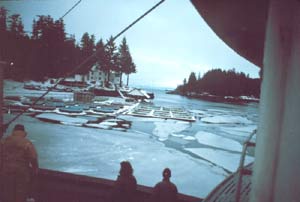|
We start our report today with a recollection of a decade ago, when Colorado wildlife researchers tried to extend the longevity of salmon by feeding them steroidal testosterone.
 None of the tested fish lived appreciably longer lives, though one of them did finish third in the 1994 Mr. Olympia contest.
None of the tested fish lived appreciably longer lives, though one of them did finish third in the 1994 Mr. Olympia contest.
More recently, "salmon farming" has become the main way of getting more salmon out of Mother Nature. A salmon farm is usually set up as a collection of open-water pens that employ netting to keep the salmon from escaping (see NOAA picture above). A pen can be up to 300 feet per side and can be used to raise about 50,000 fish. A single salmon farm may have a dozen or so pens, yielding a total of well over half a million fish in a relatively small area. Beyond any discomfort the fish may feel at their unnaturally cramped quarters, there are a number of environmental and health problems associated with these farms and the salmon that make their way from them to your dinner plate.
The hottest topic in Salmonworld these days is the concern about high concentrations of PCBs in farm-raised salmon. PCBs are a class of chemicals that can cause human health effects such as:
- cancer;
- disruption of human reproduction, including fetal brain development; and
- damage to the nervous system.
PCBs have been banned in the US for more than two decades but, because they are persistent pollutants, are still found in great concentration in the environment. They tend to "bioaccumulate" up the food chain—meaning that organisms ingest the chemicals faster than they can get rid of them, and the effect is more and more magnified the higher you go up the food chain.
Farm-raised salmon have higher levels of PCBs than wild salmon for a number of reasons:
- Their feed is designed to have higher levels of fish oil than a wild salmon would get by eating its normal diet in the open waters. Unfortunately, the fats and oils of a fish are where the PCBs accumulate, so feed higher in fish oil will also be higher in PCBs.
- Farmed salmon are bred and raised to be fatter to enhance their sale weight—much as cattle are sent to feed lots to fatten up. An ounce of farmed salmon contains 52 percent more fat than an ounce of wild salmon, according to the U.S. Department of Agriculture. Unfortunately, as with the fishmeal the farmed salmon eat, their fat is where the PCBs accumulate.
- Farmed salmon don't burn off as much of their fat because of their confinement in the fish pens.
 An independent study commissioned by the Environmental Working Group and published in 2003 found that 7 of 10 farmed salmon purchased at grocery stores in Washington DC, San Francisco, and Portland (Oregon) were contaminated with PCBs at levels that would raise health concerns. On average, the farmed salmon had 16 times the PCBs found in wild salmon.
An independent study commissioned by the Environmental Working Group and published in 2003 found that 7 of 10 farmed salmon purchased at grocery stores in Washington DC, San Francisco, and Portland (Oregon) were contaminated with PCBs at levels that would raise health concerns. On average, the farmed salmon had 16 times the PCBs found in wild salmon.
Another study, this one published in the journal Science in January 2004, sampled approximately 700 farmed and wild salmon from 16 major cities in North America and Europe. The study found that concentrations of PCBs, dioxins and two pesticides were consistently and significantly higher in farmed salmon and were two to three times higher than the recommended EPA limit for once-a-week consumption of such fish.
The salmon-farming industry likes to point out that the level of PCB contamination in farmed salmon is still within FDA health guidelines. That's true, but the levels of contamination are not within the US EPA's health guidelines, which are stricter and reflect more recent scientific findings. The authors of the Science report concluded that the concentrations of several cancer-causing substances in farmed salmon are high enough that consumers should consider restricting their consumption of farmed salmon to no more than one meal per month. They based this recommendation on US EPA methods for calculating fish consumption advisories.
The PCB problem alone is enough to make one want to throw back that farmed-salmon fillet and reel in some tasty, low-PCB wild salmon. Yes, we realize that "no-PCB salmon" would be what we all really want, but PCB contamination is so widespread that there is no such thing anymore. But we'll save our PCB tirade for another day. We're not quite done with farm-raised salmon.
|


